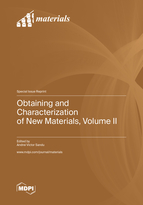Obtaining and Characterization of New Materials, Volume II
A special issue of Materials (ISSN 1996-1944). This special issue belongs to the section "Advanced Materials Characterization".
Deadline for manuscript submissions: closed (30 June 2022) | Viewed by 30375
Special Issue Editor
Interests: materials characterizations; biomaterials; geopolymers; microscopy
Special Issues, Collections and Topics in MDPI journals
Special Issue Information
Dear Colleagues,
After our first successful Special Issue "Obtaining and Characterization of New Materials", we have decided to create a second, in order to publish state-of-the-art research in the field of new materials and their understanding.
This second Special Issue, like the first one, covers a wide range of topics: obtaining and characterizing New Materials, from nano- to macro-scale, involving new alloys, ceramics, composites, biomaterials, polymers, as well as procedures and technologies for enhancing their structure, properties, and functions. In order to be able to select the future use of the new materials, we first must understand their structure, to know their characteristics, involving modern techniques such as microscopy (SEM, TEM, AFM, STM, etc.), spectroscopy (EDX, XRD, XRF, FTIR, XPS, etc.), mechanical tests (tensile, hardness, elastic modulus, toughness, etc.), and their behavior (corrosion, thermal—DSC, STA, DMA, magnetic properties, biocompatibility—in vitro and in vivo), among many others.
Prof. Dr. Andrei Victor Sandu
Guest Editor
Manuscript Submission Information
Manuscripts should be submitted online at www.mdpi.com by registering and logging in to this website. Once you are registered, click here to go to the submission form. Manuscripts can be submitted until the deadline. All submissions that pass pre-check are peer-reviewed. Accepted papers will be published continuously in the journal (as soon as accepted) and will be listed together on the special issue website. Research articles, review articles as well as short communications are invited. For planned papers, a title and short abstract (about 100 words) can be sent to the Editorial Office for announcement on this website.
Submitted manuscripts should not have been published previously, nor be under consideration for publication elsewhere (except conference proceedings papers). All manuscripts are thoroughly refereed through a single-blind peer-review process. A guide for authors and other relevant information for submission of manuscripts is available on the Instructions for Authors page. Materials is an international peer-reviewed open access semimonthly journal published by MDPI.
Please visit the Instructions for Authors page before submitting a manuscript. The Article Processing Charge (APC) for publication in this open access journal is 2600 CHF (Swiss Francs). Submitted papers should be well formatted and use good English. Authors may use MDPI's English editing service prior to publication or during author revisions.
Keywords
- new materials
- surface analysis
- structure analysis
- chemical analysis
- mechanical properties
- behaviour of materials
- functionalization







